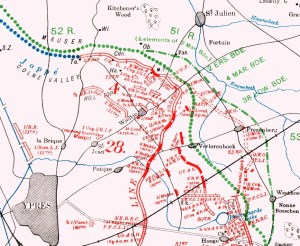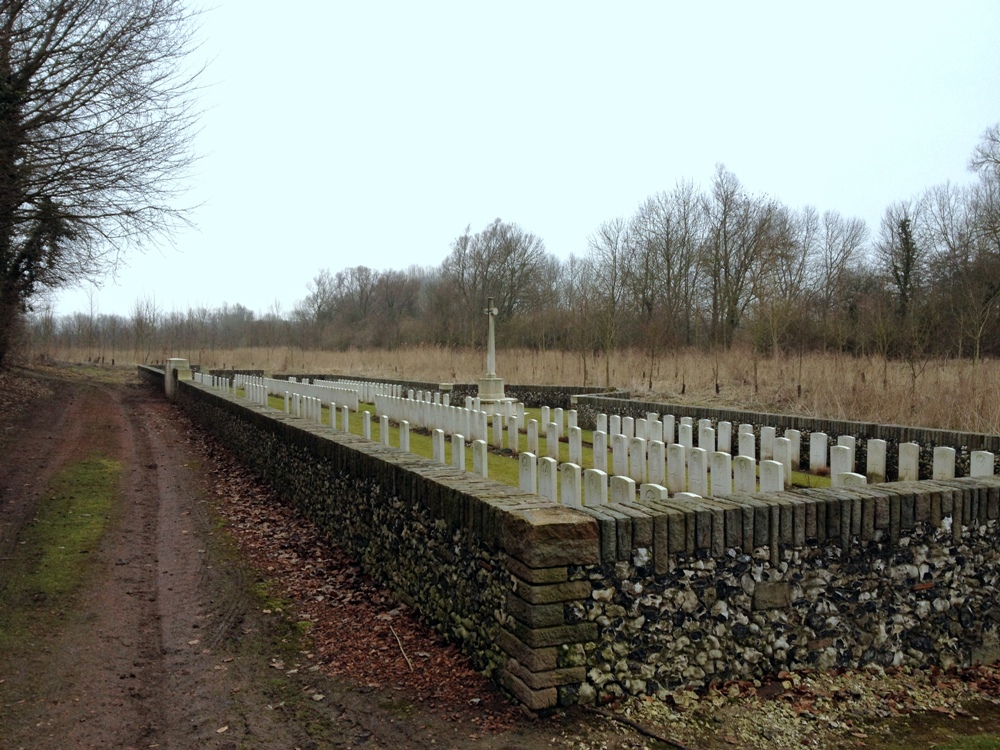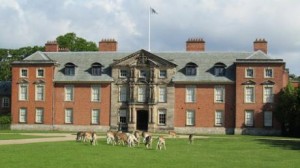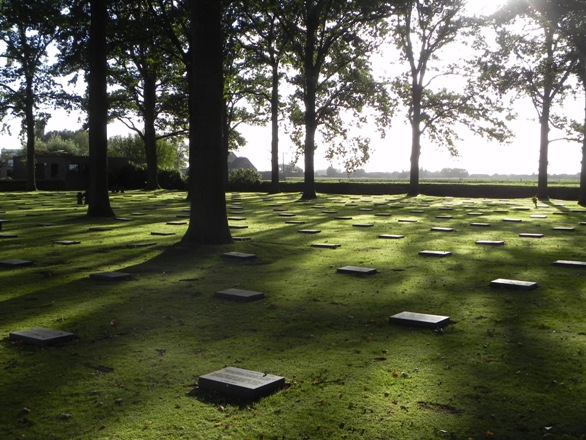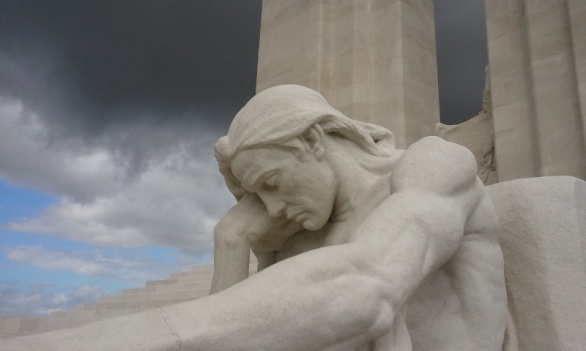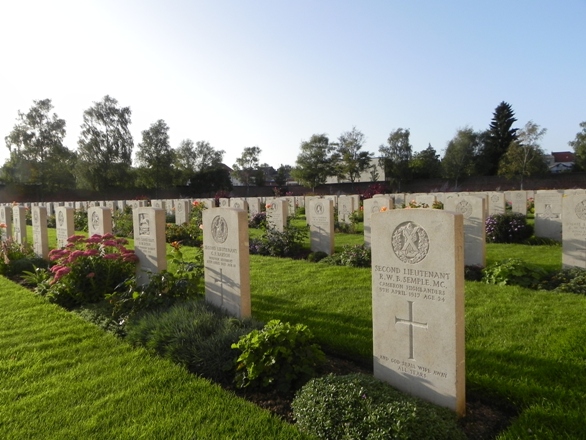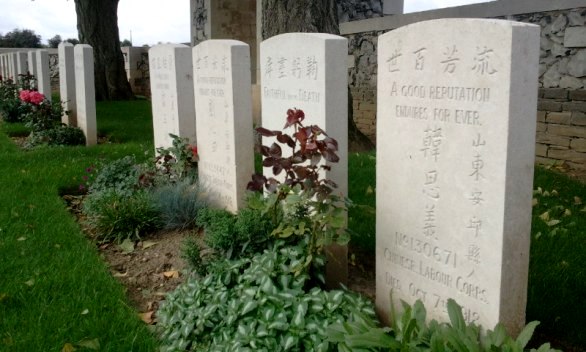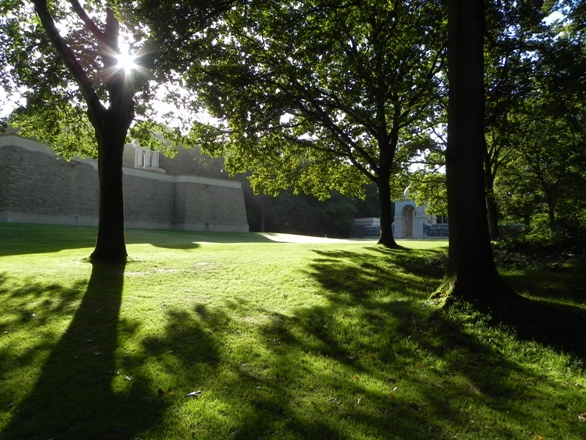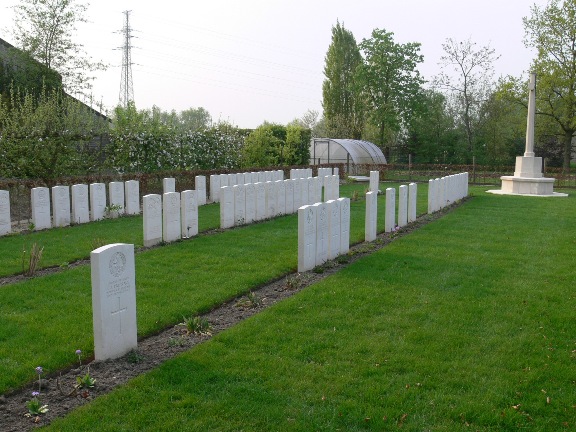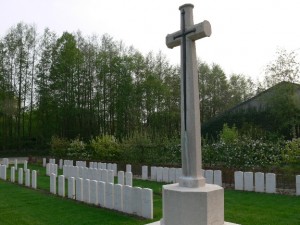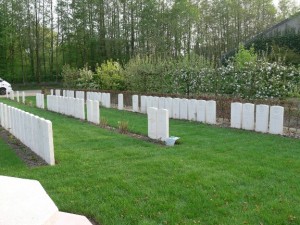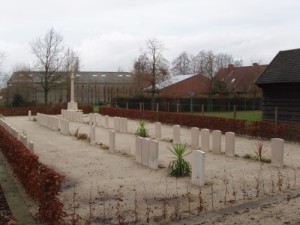Posts Tagged ‘Ypres’
New Battlefield Tour announced! Western Front Footsteps: Stories of courage and endeavour above and below the battlefield and the postwar reconstruction of French communities, 24-27 September 2021
Following the success of the four years of Bristol and West Country based battlefield tours (2016-19) organised with fellow historian, Clive Burlton, we are pleased to announce another trip for autumn 2021. Our 2020 tour was cancelled due to the coronavirus pandemic, hence we are carrying over our suggested plans for that tour to 2021. Our focus is not solely actions by units from the West Country but on this tour will look at the role of the Tunnelling Companies and their incredible underground war, fought deep beneath No Man’s Land. We will also visit sites and tell stories associated with the post-war reconstruction of French communities.
Once again we are travelling with our partners at Bakers Dolphin. The three night, four day tour will visit key sites associated with the West Country. Travelling by executive coach we will depart from Bristol on 24 September and travel to Arras, stopping at sites of interest en route.
The next day will be spent on the 1916 Somme battlefield with a look at the tunnelling exploits at such famous sites as Hawthorn Ridge, La Boisselle, Bois Francais and Carnoy. As ever we will ensure that we stop at key battlefield sites including the Thiepval Memorial.
On 26 September we will journey northward to the sacred Ypres salient and Messines Ridge, a key battleground for the tunnelling war. En route we will visit Bethune and the Tunnellers Memorial at Givenchy-les-la-Bassée for the tale of Sapper William Hackett VC, the only tunneller recipient of the Victoria Cross. Whilst in Ypres we will attend the Last Post ceremony at the Menin Gate. Other key sites around the salient will be explored.
As ever, our tour will cover the stories of relatives of those who join us. Please do send details and we will endeavour to visit individual graves and battlefield sites if time permits.
Accommodation is based at the following 3-star hotels – Holiday Inn Express (Arras) and the Novotel (Ypres). Full details of cost, what is included and contact details to reserve a space can be found on the attached flyer and via our dedicated website: https://westernfrontfootsteps.com/.
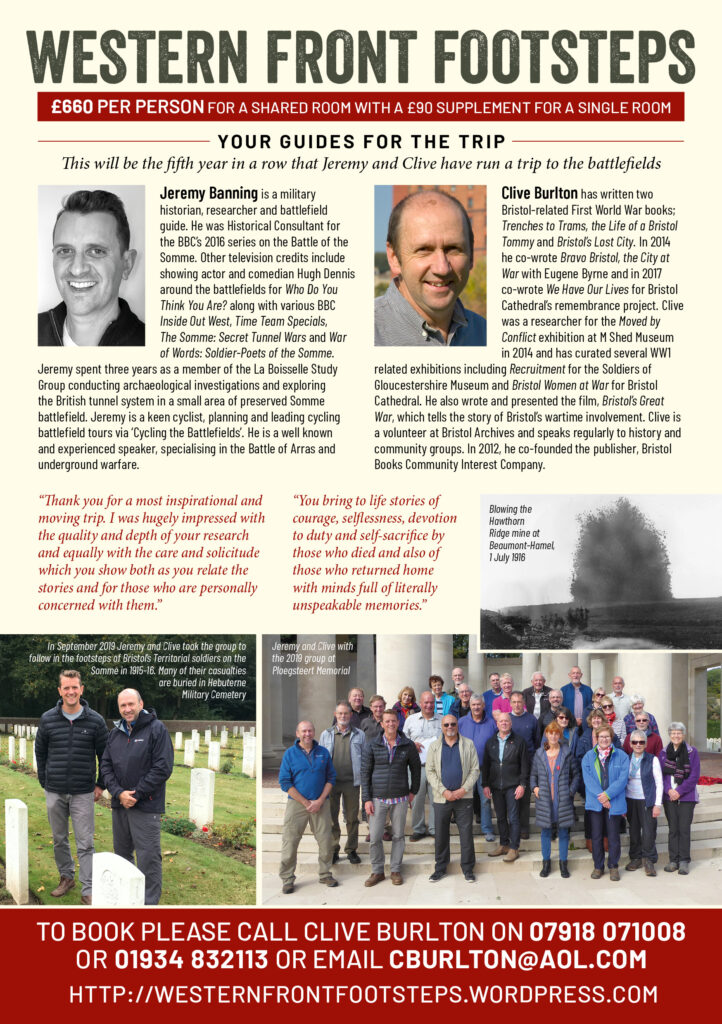
We look forward to you joining us for another wonderful few days following in some Western Front Footsteps…
Following the success of the last three years of Bristol and West Country based battlefield tours organised with fellow historian, Clive Burlton, we are pleased to announce another trip for this coming autumn. This time our focus is not solely actions by units from the West Country but a look at associated stories of the postwar period of battlefield tourism and creation of Commonwealth War Graves Commission cemeteries.

Once again we are travelling with our partners at Bakers Dolphin. The three night, four day tour will visit key sites associated with the West Country. Travelling by executive coach we will depart from Bristol on 27 September and travel to Arras, stopping at sites of interest en route. If time permits we will visit Fresnoy near Arras where the 12th Gloucesters (Bristol’s Own) fought with heavy losses in May 1917.
The next day will be spent on the 1916 Somme battlefield with a look at the Bristol Territorials at Hebuterne and a visit to key battlefield sites including the Thiepval Memorial. On our way down to the Somme we aim to stop at Mory Abbey Military Cemetery to hear a most moving story of a father’s love for his son.
On 29 September we will journey northward to the sacred Ypres salient , the wartime cauldron for so many of Britain’s soldiers. Whilst in Ypres we will attend the Last Post ceremony at the Menin Gate and walk in the footsteps of the 1st Somerset Light Infantry in December 1914 at Ploegsteert (known as Plugstreet to the Tommies). Other key sites around the salient will be explored. Throughout the trip we will be looking at the work of the war artists such as Nash, Levinson and Orpen.
As ever, our tour is based around the stories of relatives of those who join us. Please do send us details and we will endeavour to visit individual graves and battlefield sites.
Accommodation is based at the following 3-star hotels – Holiday Inn Express (Arras) and the Novotel (Ypres). Full details of cost, what is included and contact details to reserve a space can be found on the attached flyer.
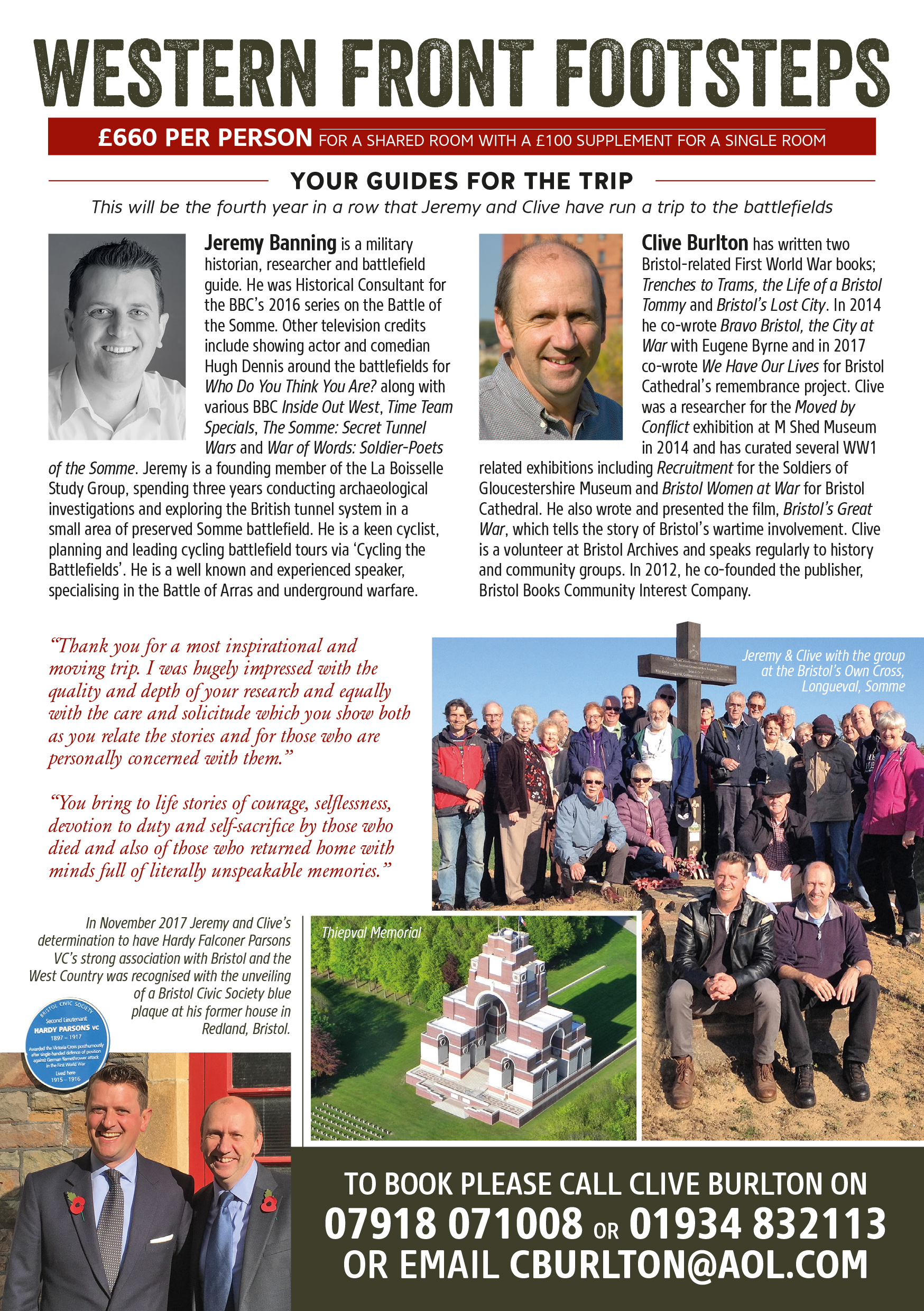
We look forward to you joining us for another wonderful few days following in some Western Front Footsteps…
New Battlefield Tour announced! ‘Western Front Footsteps’ 28 September – 1 October 2018
Following the success of 2016’s ‘Bristol on the Western Front’ and last year’s ‘The West Country at War’ tour trip that I organised with fellow historian, Clive Burlton, we are pleased to announce another trip for this coming autumn.
Stops will cover actions by units from Wiltshire, Somerset and South Wales as well as Bristol. The tour is named ‘Western Front Footsteps’.
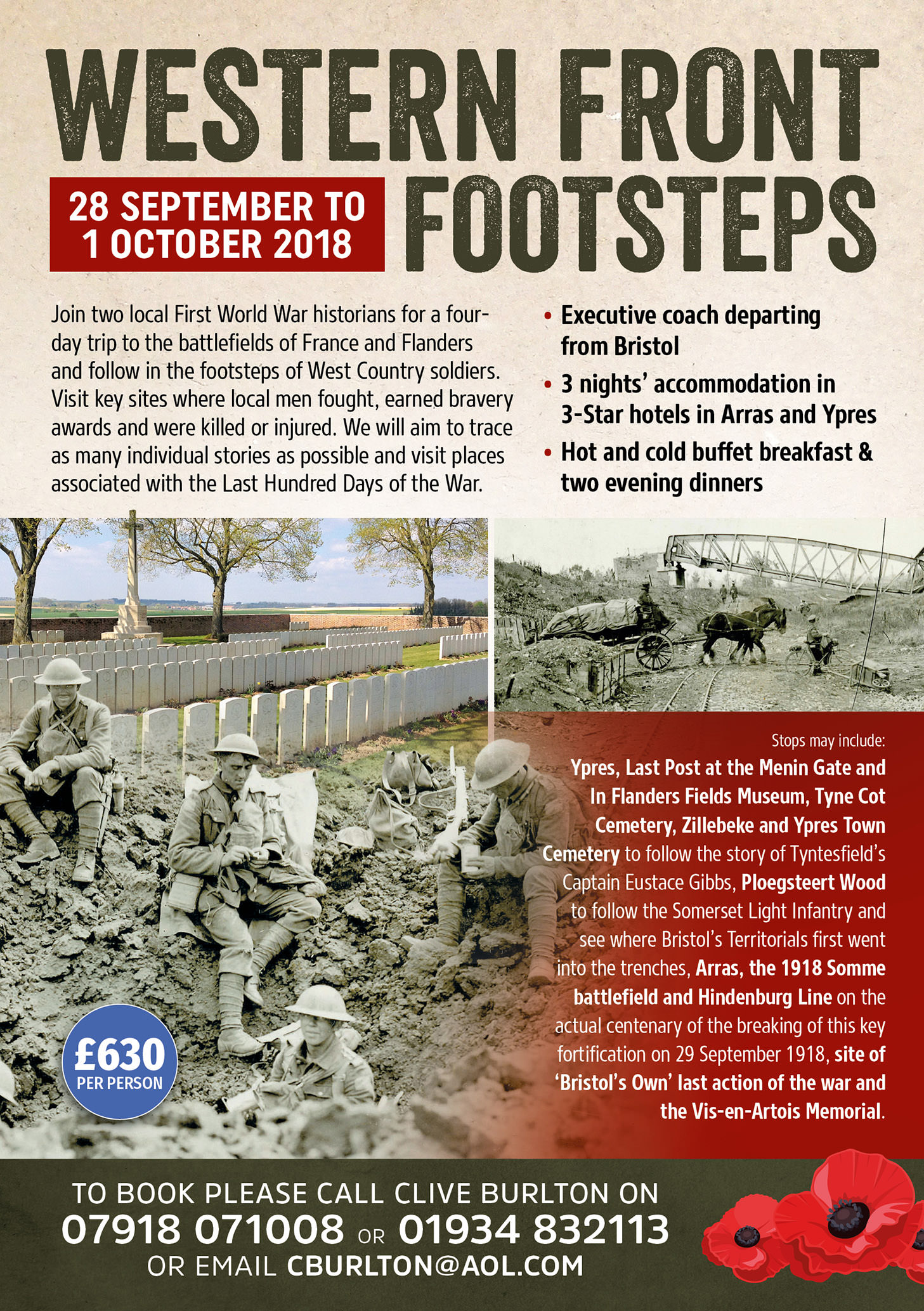
Once again we are travelling with our partners at Bakers Dolphin. The three night, four day tour will visit key sites where soldiers from the West Country fought, earned bravery awards and lost their lives.
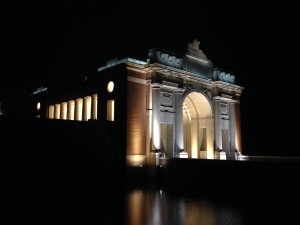
Menin Gate, Ypres
Travelling by executive coach we will depart from Bristol on 28 September and travel to Arras, stopping at sites of interest en route. The next day will be spent on the 1918 Somme battlefield on the centenary of the breaking of the Hindenburg Line – a momentous day that paved the way to allied victory. It is also the centenary of the last assault ever made by the 12th Gloucesters (Bristol’s Own) and we will walk their final attack. It will be special to visit this fascinating battlefield on such a poignant day.
On 30 September we will journey northward to the sacred Ypres salient , the wartime cauldron for so many of Britain’s soldiers. Whilst in Ypres we will attend the Last Post ceremony at the Menin Gate and visit the In Flanders Fields Museum in the Cloth Hall. Our time in Ypres will see us visiting sites around the salient including Ploegsteert (known as Plugstreet to the Tommies) to follow the 1st Somerset Light Infantry in December 1914, see where the Christmas Truce took place and visit the area in which Bristol’s Territorials first went into the trenches.

A key theme of this year’s tour will be looking into the wartime history of the Gibbs family from Tyntesfield (now a National Trust property) – their story is fascinating and heart-rending.

Ypres Cloth Hall – now the location for the In Flanders Fields Museum
Accommodation is based at the following 3-star hotels – Holiday Inn Express (Arras) and the Novotel (Ypres). Full details of cost, what is included and contact details to reserve a space can be found on the attached flyer.
We look forward to you joining us for another wonderful few days following in some Western Front Footsteps!
Following the success of last year’s ‘Bristol on the Western Front’ trip that I organised with fellow historian, Clive Burlton, we are pleased to announce another trip for October 2017.
This year we are broadening the net with less of a Bristolian focus. Stops will cover actions by units from Wiltshire, Somerset and South Wales. As such, we thought it apt to name the tour ‘The West Country at War’.
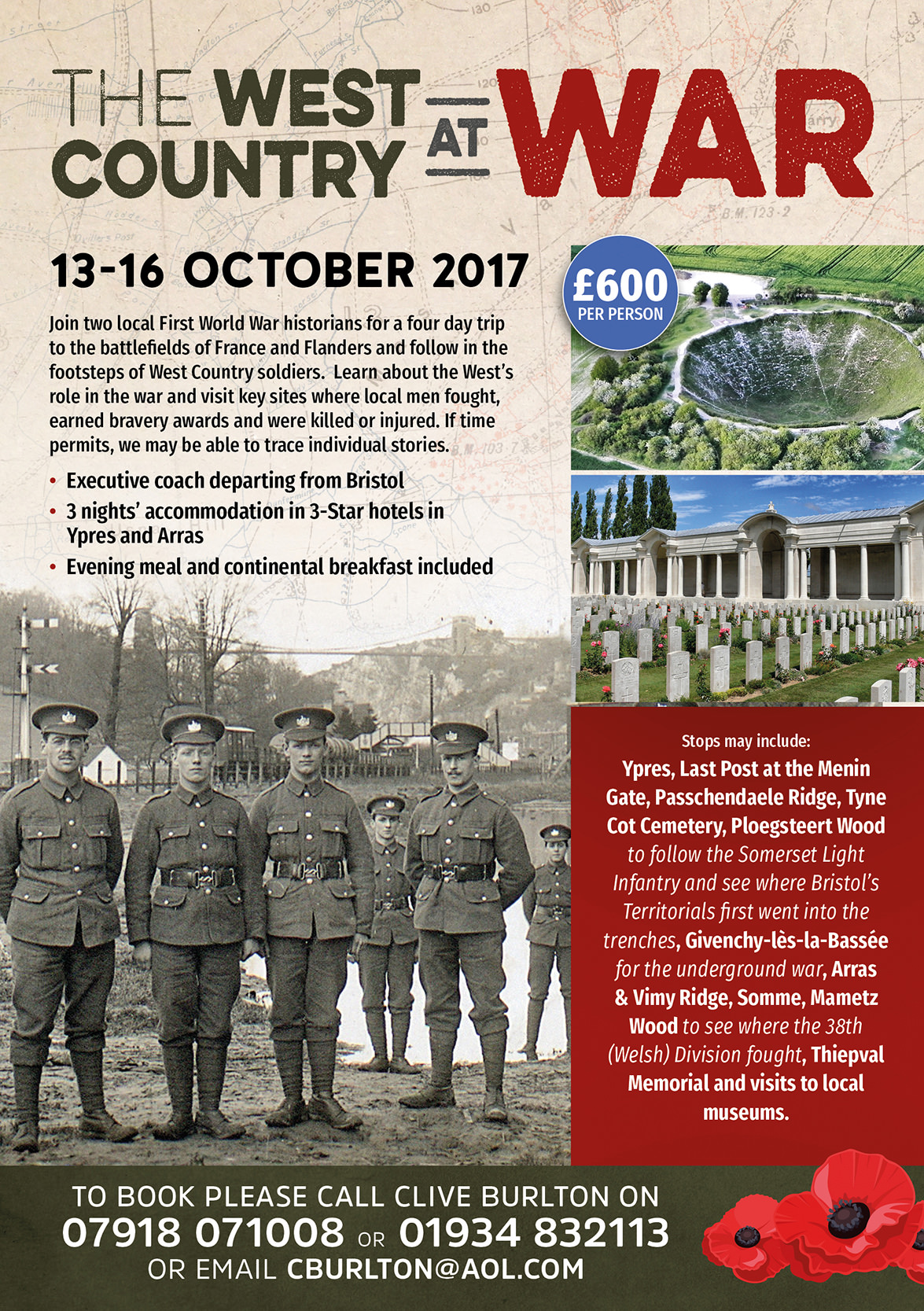
Once again we are travelling with our partners at Bakers Dolphin. The three night, four day tour will visit key sites where soldiers from the West Country fought, earned bravery awards and lost their lives.

Menin Gate, Ypres
Travelling by executive coach we will depart from Bristol on 13 October and travel to Arras, stopping at sites of interest en route. The next day will be spent on the Somme battlefields, visiting some well known (Mametz Wood) as well as lesser known sites on the 1917 battlefield!
The following day sees us journey northward to the sacred Ypres salient , the wartime cauldron for so many of Britain’s soldiers. Whilst in Ypres we will attend the Last Post ceremony at the Menin Gate. Our time in Ypres will see us visiting sites around the salient including Ploegsteert (known as Plugstreet to the Tommies) to follow the 1st Somerset Light Infantry in December 1914, see where the Christmas Truce took place and visit the area in which Bristol’s Territorials first went into the trenches.
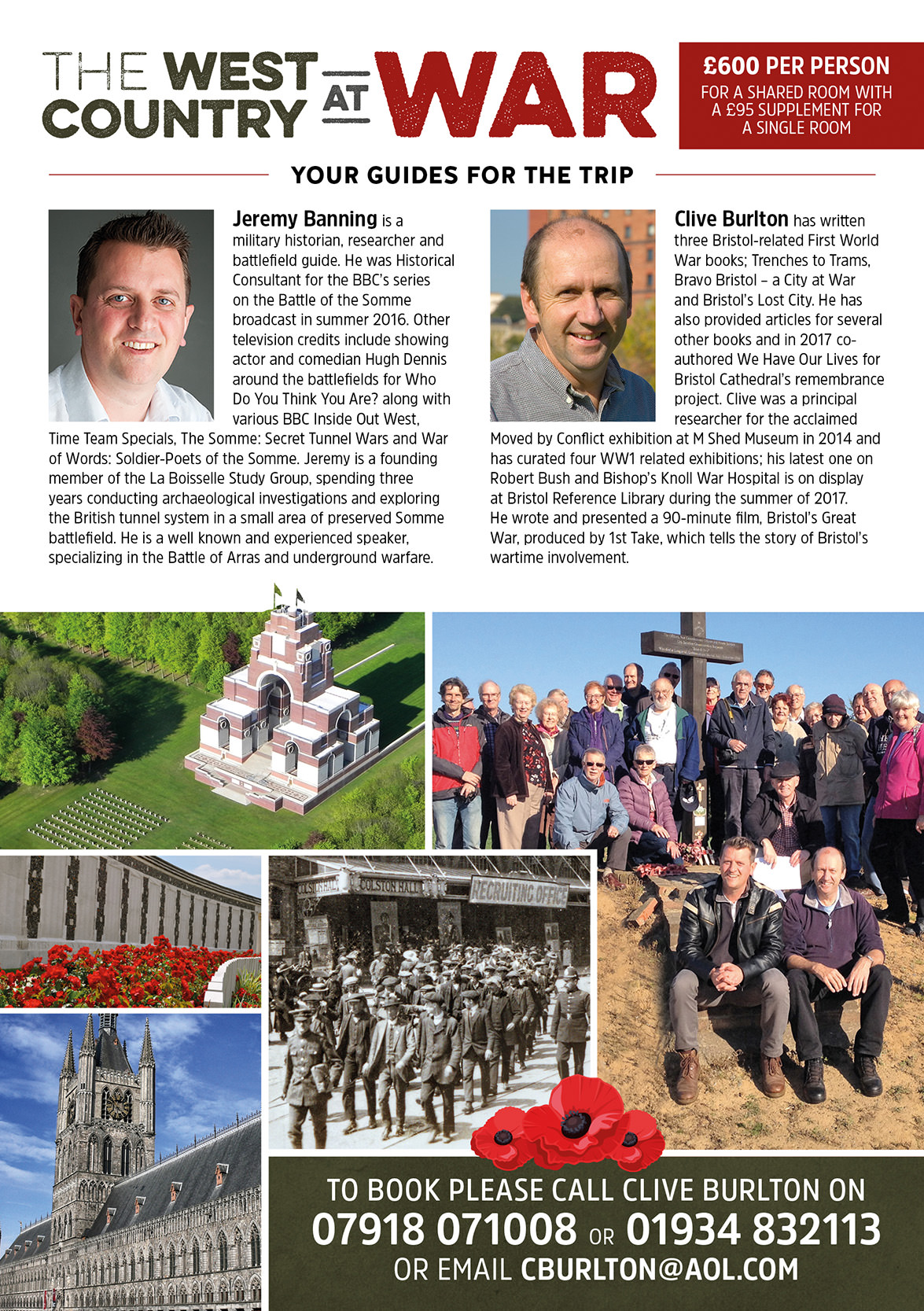
Accommodation is based at the following 3-star hotels – Holiday Inn Express (Arras) and the Novotel (Ypres). Evening meal and continental breakfast are included. If there is demand then Clive and I are happy to give evening talks. Last year we were heartened by the almost 100% attendance rate at our talks by those who had already had a long day on the battlefields.
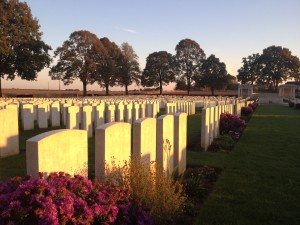
Delville Wood Cemetery, Somme
Full details of cost and contact details to reserve a space can be found on the attached flyer.
We look forward to you joining us for another wonderful few days!
Through my work for Historic England I have come to know many stories of Bristol’s soldiers in the war. A few years ago I met Clive Burlton, a local historian and writer with a superb knowledge of Bristol’s role in the war. Clive and I have given talks at the same venue on a number of occasions and over a post-talk beer often discussed the possibility of running a coach tour to the battlefields for people who want to find out more about Bristol’s wartime story.
So, here we are! I am pleased to announce that, with our partners at Bakers Dolphin, we are running a special tour:
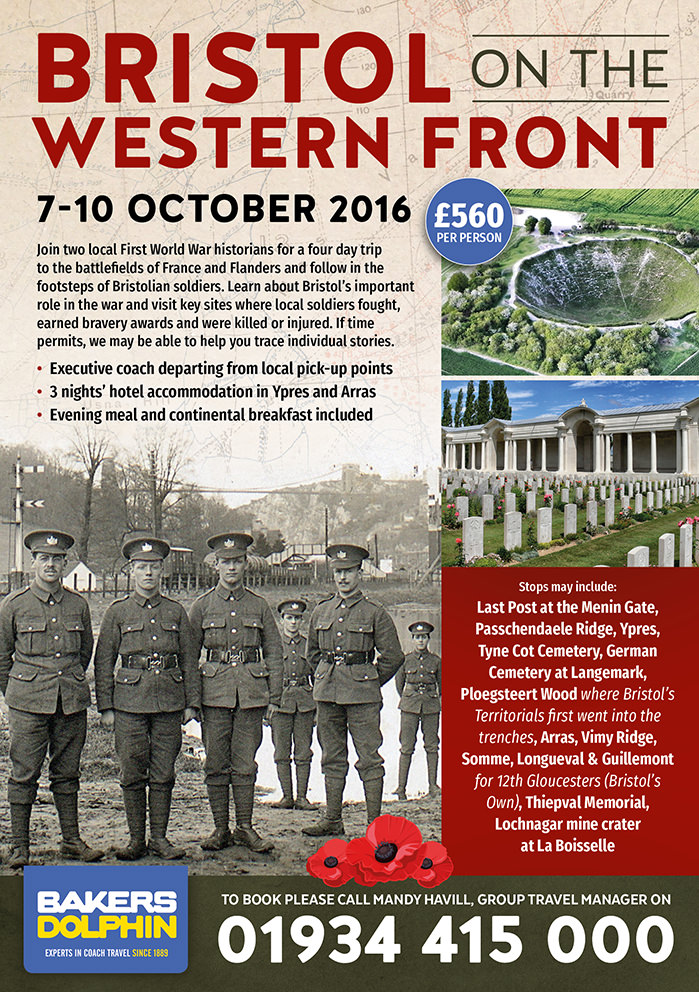
The three night, four day tour will visit key sites where soldiers from Bristol fought, earned bravery awards and lost their lives.
Travelling by executive coach we will depart from Bristol on 7 October and travel to the sacred Ypres salient, the wartime cauldron for so many of Britain’s soldiers. That evening we will attend the Last Post ceremony at the Menin Gate that night. The next day sees us visiting sites around the salient including Ploegsteert (known as Plugstreet to the Tommies) to see where Bristol’s Territorials first went into the trenches before heading south to Arras, our base for the remainder of the trip.
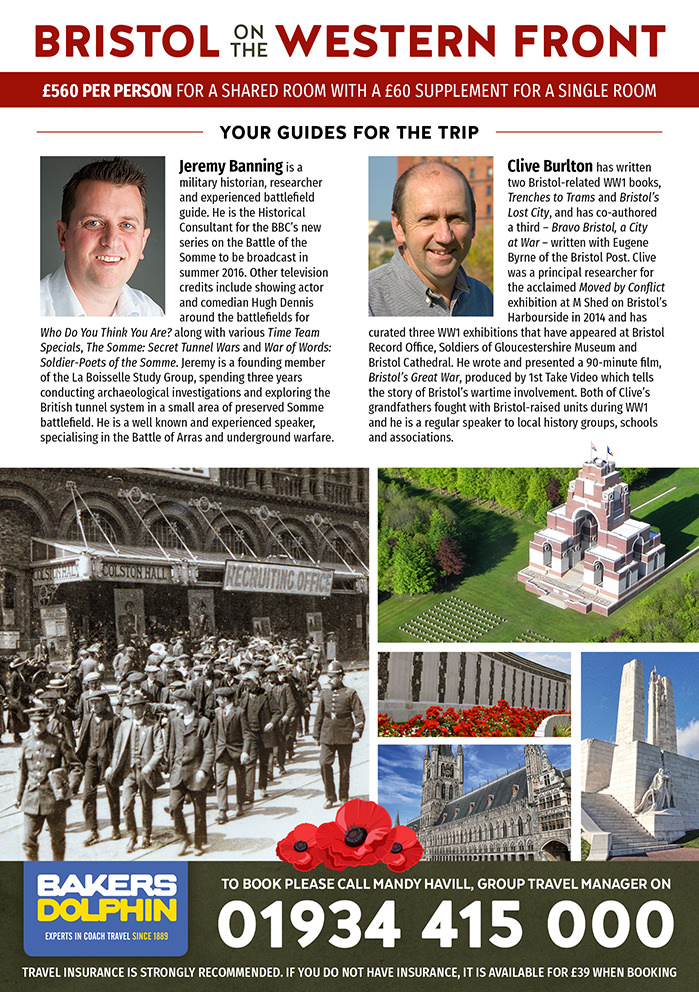
On Saturday 9th we will spend a day on the Somme battlefields, visiting key sites such as Newfoundland Memorial Park, Thiepval Memorial and the Lochnagar Mine Crater. We will also look at the story of the 12th Gloucesters (Bristol’s Own) in their actions at Longueval and Guillemont. The morning of our final day will be spent on the Arras battlefield, looking at the events surrounding the 12th Gloucesters (Bristol’s Own) action at Fresnoy on 8-9 May 1917.
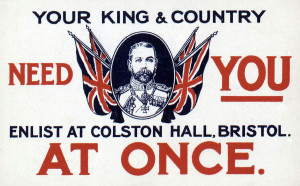
Wartime recruiting card for local soldiers to enlist at Colston Hall, Bristol
Accommodation is based at the following 3-star hotels – Novotel (Ypres) and Holiday Inn Express (Arras). Evening meal and continental breakfast are included. If there is demand then I will give a talk on the tunnellers’ war after dinner one night and Clive on a particular Bristol story the next night.
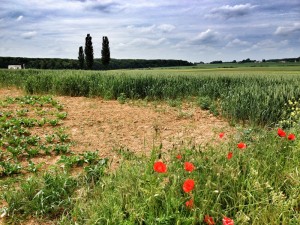
Guillemont – 12th Gloucesters (Bristol’s Own) attacked close to here on 3 September 1916
Individual visits can be accommodated if time permits and locations are close by.
The cost is a competitive £560pp, based on a shared room. For more details please contact me HERE or Mandy Havill, Group Travel Manager on 01934 415 000. I look forward to meeting you on the tour and sharing in Bristol’s fascinating history.
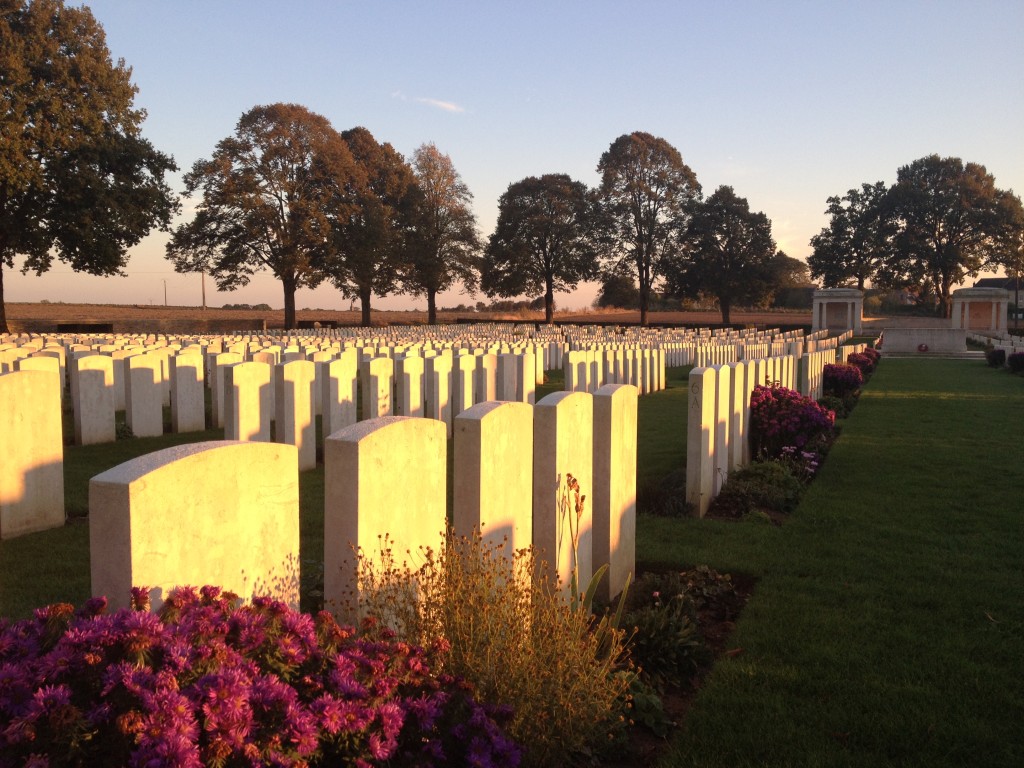
Delville Wood Cemetery, Somme
This brief article will look at the actions and casualties sustained by the 2nd Battalion Royal Dublin Fusiliers (part of 10th Brigade, 4th Division) during the Second Battle of Ypres. One often feel when visiting the Ypres Salient that the sheer horror of the Third Battle (Passchendaele), fought during the summer and autumn of 1917, can overshadow earlier clashes. Many first-time visitors may be unaware of the horrendous casualties sustained by the British in earlier desperate defensive battles (First Ypres – Oct-Nov 1914) and Second Ypres (April-May 1915). The latter battle saw the advent of chemical warfare when the Germans released chlorine gas on a four mile frontage in the late afternoon of 22 April against two French divisions defending the north of the salient. Gas also drifted across Canadian positions holding the left flank of the British. The initial success of this experimental weapon, which left a trail of dead and dying in its wake, enabled the Germans to advance from the fields around Poelcapelle and Langemarck to Steenstraat on the Yser Canal. The stalwart defence of the untried 1st Canadian Division (my grandfather, a private in the 13th Battalion CEF, amongst them) and the rushing forward of British troops to plug the gap around Ypres is not the subject of this article. However, this defence must be appreciated to put the specific story of the 2nd Royal Dublin Fusiliers into context. Not surprisingly, considering their initial success, the Germans used gas on a number of other occasions during the battle, culminating in the Battle of Bellewaarde Ridge on 24-25 May. A terrifically detailed description of the opening phase of Second Ypres can be found here: http://www.greatwar.co.uk/battles/second-ypres-1915/index.htm.
Into action
On 23 April 2nd Royal Dublin Fusiliers were told to stand by and be prepared to move at a half hours notice. The following day they marched via Vlamertinghe to the outskirts of Ypres and at midnight to St Jean where they deployed west of the Wieltje – St Jean road at 4am. The Battalion War Diary records they suffered heavy casualties digging in on a line a quarter of a mile from and facing St Julien. There follows a ‘quiet morning up to 11am’ until the Northumbrian Infantry Brigade attacked through their trenches. During this period Captain Banks was killed, his command being assumed by Captain Basil Maclear. The War Diary records ‘heavy shelling throughout the day, and intermittent musketry’. There follows a few days of relative quiet which is shattered on 2 May when, in a foretaste of future action, the enemy attacked under cover of gas. Men of the left hand company were most affected but the German attack failed to reach the 2nd Royal Dublin Fusiliers trenches.
After relief on 4 May the Battalion bivouacked on the east bank of the Yser Canal, a half mile north west of La Brique. This period away from the front line was shortlived as the Germans made a concerted effort to break the British line. This attack, made against the 27th and 28th Divisions on 8 May, began what was named by the post-war Battles Nomenclature Committee, the Battle of Frezenberg Ridge. A violent German artillery bombardment caused terrible destruction to the British defences. Whilst avoiding this initial bombardment the 2nd Royal Dublin Fusiliers were warned at noon to be prepared to move forward to support 81st Infantry Brigade. Ninety minutes later the battalion (in fighting order) left their bivouac and joined the 1st Royal Warwickshire Regiment outside Ypres, moving to the wood by Potijze Chateau. Heavy shell fire was recorded throughout the afternoon and evening. On three separate occasions the Battalion deployed beyond the British barbed wire to assault the German trenches North of Potijze Woods. Each time the attack was cancelled. However, the body of men in the open presented an easy target for German machine gunners; the War Diary records that ‘machine guns did considerable damage’. To compound the misery the rations failed to arrive.
That night the battalion occupied what was left of the GHQ Line, their left being 150 yards south east of Shell Trap Farm (later renamed Mouse Trap Farm), lying immediately north of the Wieltje – St Julien road. One company was held in reserve in trenches north of Potijze Wood. The War Diary describes 9 May as “One of the worst days shelling [the] Battalion experienced.” German machine gun and accurate sniper fire added to the difficulties. After a few days in these positions the Battalion was relieved, moving back to Vlamertinghe Chateau before returning to the trenches on 19 May. The War Diary records little of interest in the following few days other than intermittent shelling and sniping. The entry for 23 May records a “Quiet day and night”. The Dubliners were not know it but that quiet night was the calm before the storm.
Shell Trap Farm – 24 May 1915 gas attack (The Battle of Bellewaarde Ridge)
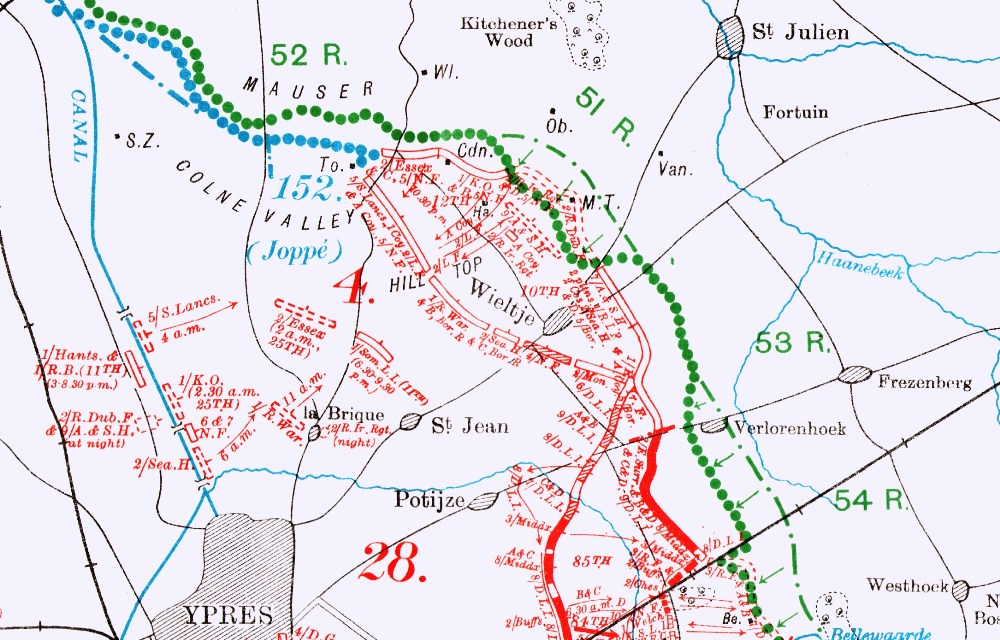
Official History map showing position occupied by 2nd Royal Dublin Fusiliers at Shell Trap Farm, 24 May 1915
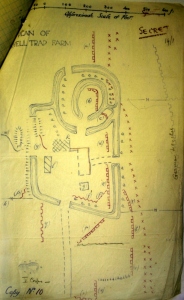
Detailed sketch map showing trench positions around Shell Trap Farm prior to 24 May gas attack. Image taken from 4th Division General Staff HQ May 1915 War Diay (NA Ref: WO95/1442) and is reproduced with permission from the National Archives.
At 2.45am on 24 May the enemy attacked with gas. The area round Shell Trap Farm and to its immediate north west was most affected. A detailed report of the events of 24 May 1915 by Captain Thomas J Leahy (incorrectly transcribed as Linky in the report) is attached to the Battalion War Diary. Leahy describes that their C.O., Lieutenant Colonel Arthur Loveband has suspected gas may be used when inspecting the trenches at Shell Trap Farm earlier that night. He had personally warned all Company officers to be prepared whilst Major Russell (RAMC) had inspected all that Vermoral sprayers and warned each company about damping their respirators. Leahy’s report notes there were ten sprayers in working order that night, one with each machine gun and the remainder distributed along the trenches.
When seeing red lights thrown up from the German trenches (a signal for the gas release) Lt-Col Loveband shouted “Get your respirators boys, here comes the gas”. Leahy notes how little time they had; “we had only just time to get our respirators on before the gas was over us”. There was a gentle breeze, the gas cloud being very dense took about three quarters of an hour to pass over the Fusiliers’ position. German parties advanced in small numbers at 4.30am, occupying the British line north and to left of the Battalion’s trenches. With these trenches occupied, the Battalion was now subjected to enfilade fire. Under heavy shellfire and aided by part of two companies of the 9th Argyll & Sutherland Highlanders the Battalion held to their trenches to the end. The report makes harrowing reading, containing transcripts of signals sent by isolated parties within the farm complex. Even a hundred years after the event it is clear to sense the fear in 2nd Lieutenant Robert Kempston from B Company’s message which simply stated “For God’s sake send us some help. We are nearly done”. Kempston was killed later that day. Whilst speaking to officers outside his dugout Lt-Colonel Loveband was also killed when a bullet struck him through the heart.
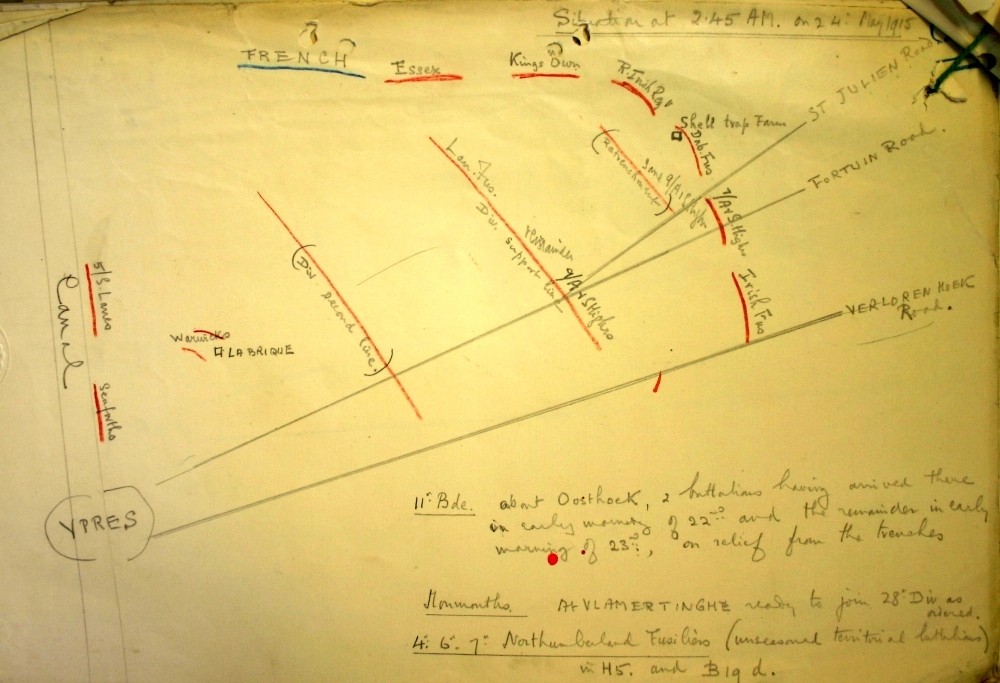
Sketch map showing situation at 2.45am on 24 May 1915. Image taken from 4th Division General Staff HQ May 1915 War Diary (NA Ref: WO95/1442) and is reproduced with permission from the National Archives.
The War Diary records “Germans advancing under cover of enfilade fire, in small parties, finally occupied Battalion line by 2.30pm. Shelling ceased but rifle and M.G. fire remained accurate and constant, whenever a target presented itself, until dusk.” In the face of such a breakthrough it was decided, that evening, to withdraw to a more defensible line. Exhausted by their staunch defence the Battalion was withdrawn at 9.30pm and bivouacked on the west bank of the canal.
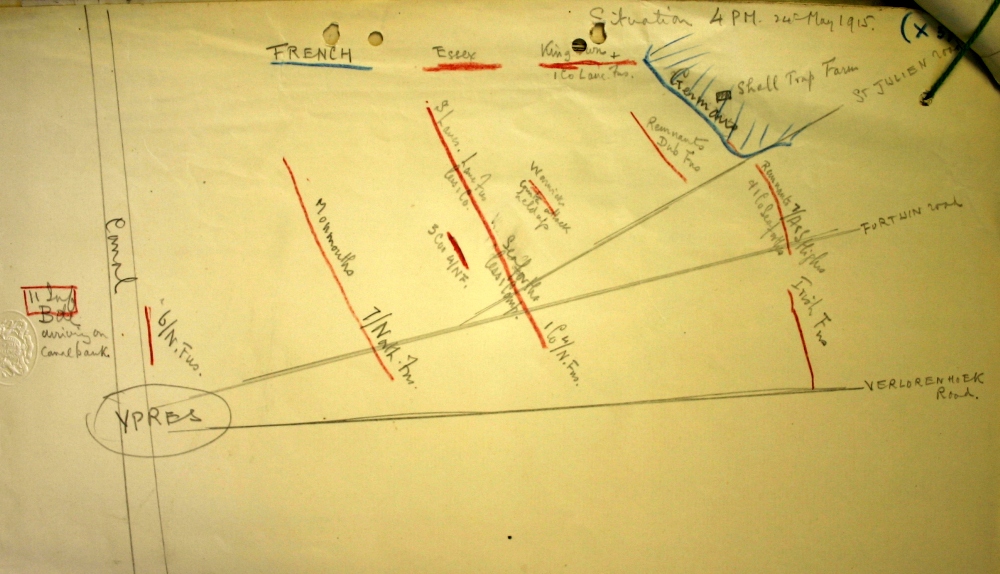
Sketch map showing situation at 4pm on 24 May 1915 after German gas attack. Image taken from 4th Division General Staff HQ May 1915 War Diary (NA Ref: WO95/1442) and is reproduced with permission from the National Archives.
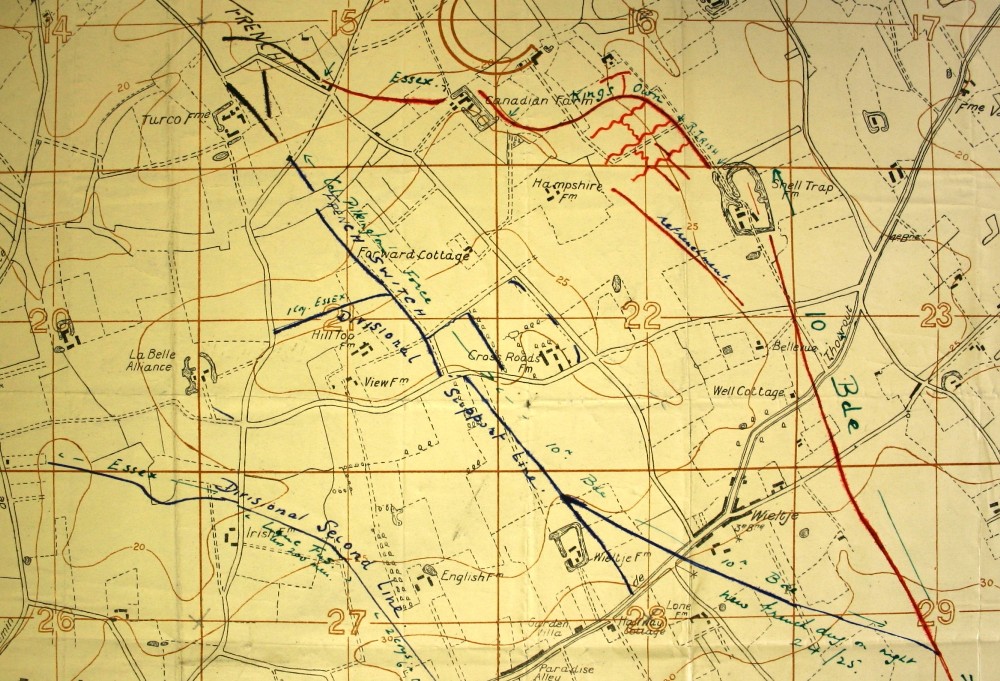
Trench map of positions around Shell Trap Farm. Red lines show the trench positions prior to the 24 May gas attack whilst the blue lines correspond to final positions after the attack. Image taken from 4th Division General Staff HQ May 1915 War Diary (NA Ref: WO95/1442) and is reproduced with permission from the National Archives.
The cost
The War Diary records the Battalion strength in trenches on the morning of 24 May was 17 officers & 651 other ranks. Such had been the ferocity of the fighting, the shellfire, rifle and machine gun fire with the addition of the night-time chlorine gas attack that, when relieved, only one officer and 20 other ranks crossed the canal. What remained of the Battalion (reinforced by a draft) moved back to Vlamertinghe Chateau the following day. The entire Battalion strength was only 2 officers and 190 other ranks.
Leahy’s report concludes with these words:
“When the wounded were sent away after dark there were no Dublins in front of Battalion Headquarters. From about 2.30pm there was no fighting in our trenches. Everyone held onto them to the last. There was no surrender, no retirement and no quarter given or accepted. They all died fighting at their posts.”
Inspecting the shattered remnants of the battalion on 28 May, General Sir William Pulteney commanding III Corps commented how sad it was to see so few remaining and emphasised the fact that the Battalion should console itself with the knowledge that those who had gone had “Done their job”.
Astonishingly, the Battalion (at full strength 1027 officers and men) suffered just under 1,500 casualties in one calendar month from 24 April – 24 May 1915. This figure clearly includes reinforcements who made up earlier losses. Most of these casualties were sustained during three distinct period in the line. I have copied the relevant dates from the summary given in full below:
- 25 April: 7 officers killed, 8 wounded. Other ranks: 45 killed, 80 wounded, 371 missing
- 9-10 May: 4 officers killed, 3 wounded. Other ranks: 37 killed, 60 wounded, 185 missing
- 24 May: 9 officers killed, 1 wounded, 1 gassed, 1 missing, 1 POW. Other ranks: 14 killed, 35 wounded, 547 missing
For more information Thomas Stephen Burke’s ‘The 2nd Battalion Royal Dublin Fusiliers and the Tragedy of Mouse Trap Farm: April and May 1915’ is well worth a read. Shell Trap Farm (renamed Mouse Trap Farm) stayed in German hands from May 1915 until its capture at the start of the Passchendaele offensive on 31 July 1917.
Researching the war service of David Emanuel’s grandfather, John Leslie Emanuel, for BBC Wales ‘Coming Home’
In June I spent a day in Merthyr Tydfil filming with Yellow Duck Productions for their hit BBC Wales genealogy programme, ‘Coming Home’. Having worked with Yellow Duck on a previous series I was asked to research the wartime service of John Leslie Emanuel, grandfather to the fashion designer David Emanuel.
As was revealed in tonight’s broadcast, David never met grandfather who drowned in a tragic accident in December 1939. Whilst aware of his grandfather’s drowning, David had little knowledge of his wartime military service. We had a lucky start in that his grandfather’s service record survived. Using this and extant unit war diaries I was able to show David where his grandfather had served.
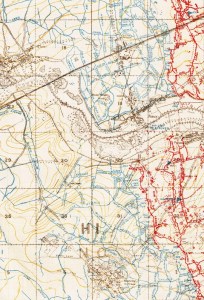
Trench map extract of the Roeux – Monchy area – positions occupied by 234 Machine Gun Company in summer 1917. Crump Trench runs just to the south of the railway line in the area west of the village of Roeux.
John Leslie Emanuel enlisted in February 1916 in the Sussex Yeomanry and proceeded to France in September of that year, joining the 10th Battalion Queen’s (Royal West Surrey Regiment). He soon transferred to 124 Machine Gun Company, spending six months on the Western Front, mostly in positions facing the enemy on the Messines Ridge. His active service was interrupted by his evacuation back to Britain, suffering from P.U.O. (pyrexia of unknown origin).
Four months later, having recovered, been promoted to Corporal and now serving with 234 Machine Gun Company, he again proceeded overseas. The unit war diary recorded the men swam in the sea off Le Havre (noting the water was warm!) before moving to the Arras sector. The Battle of Arras had ground to a bloody halt in mid May 1917 but isolated actions continued into the summer. The main British effort for summer 1917 was focused on endeavours in Flanders. However, this did not mean that 234 MGC had an easy time of it in Artois.

Extract from 234 Machine Gun Company War Diary 18 August 1917. Held at National Archives, Kew under Ref: WO95/1472/2 and reproduced with their permission.
The war diary is illustrative of the kind of routine and boredom of trench life but occasionally reveals periods of terror. 234 MGC was serving either side of the River Scarpe, providng support to the infantry occupying positions north of Monchy-le-Preux and in the village of Roeux, scene of bitter fighting in April and May. On 18 August an 8 inch German shell demolished a dug out near an anti-aircraft position in Crump Trench. Two of the occupants were killed outright but the machine gunners survived, despite being buried and badly shaken. A CWGC cemetery, named after Crump Trench now sits on the trench location.
A month later the company moved up to Flanders to take their part in the British offensive – the Third Battle of Ypres (Passchendaele). What struck me when looking at David’s grandfather’s story is that he was sent to a Corps rest camp for the entire period 234 MGC was in action near Langemarck. It is possible this period of rest was astonishingly good luck on his part. However, with the unit having undergone a fortnight’s training prior to their deployment north, it seems a strange time for a Corporal to be given leave. Detailed records are missing but it may have been that, after the rigours of the Arras sector, he simply needed a break. Despite popular modern misconceptions there was an appreciation of mental fatigue and it was understood that often men needed a rest away from the guns to recover. Put simply, no man whose mind was in a fragile state would have been of any use in the artillery war that dominated the Flanders battles. This omission may well have saved his life as the company inevitably took casualties when engaged in battle. Upon leaving Flanders 234 MGC returned to the Arras sector. In mid-December 1917 John Leslie Emanuel was sent back to Britain as a candidate for a commission. He never saw active service again, being discharged before the armistice.
David Emanuel gave an interview to Wales Online about his participation in ‘Coming Home’: http://www.walesonline.co.uk/whats-on/film-news/david-emanuel-war-hero-granddad-8149943
Earlier this autumn I spoke to the staff and volunteers at Dunham Massey Hall, a National Trust property in Cheshire. I had been approached some months before to help with their ambitious First World War project ‘Sanctuary from the Trenches’ which will see the hall will open its doors on 1 March 2014 as Stamford Military Hospital, the convalescent hospital in which 281 soldiers were treated between April 1917 and January 1919. Lady Stamford’s original plan to turn the hall over for use as a hospital for officers was altered, perhaps due to the sheer number of wounded men, and when the doors opened in April 1917 the hospital cared solely for ‘Other Ranks’.
My role in this project was to interpret the wealth of material gathered by the team of volunteers, pick a representative sample of men from those chosen and use their stories in a lecture to not only explain the conduct of the war in 1917-18 but also elaborate on the daily routine of trench warfare, evacuation of sick and wounded and medical treatment received by the men. The information uncovered by volunteers was prodigious; there was no shortage of material related to the soldiers’ stay at Stamford Military Hospital. What was lacking was an appreciation of where those men had come from, in what actions they had fought and been wounded and what happened to them after their recuperation.
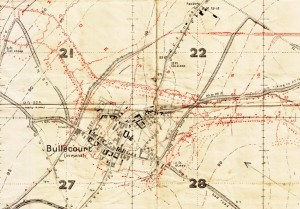
Bullecourt trench map extract. Two of the men who recuperated at Stamford Military Hospital were wounded here on 3 May 1917.
Casualties studied included a man of the 11th Rifle Brigade wounded near Havrincourt Wood in the push to the Hindenburg Line in early April 197, two men caught up in the Hindenburg Line itself at Bullecourt in May and a French Canadian wounded on Vimy Ridge. I was also able to use descriptions from my research into the Battle of Arras to illustrate the actions at Fampoux and Roeux in which a soldier of the 2nd Duke of Wellington’s (West Riding) Regiment was badly injured. Moving northwards to Flanders I was able to look at the Battle of Messines (June 1917) with Private John Ditchburn, 9th Yorkshire Regiment, wounded close to Hill 60 on 7 June and two further casualties from the Third Battle of Ypres. Sources used included Medal Index Cards, Service Records (where available) and Census Returns. By scouring Brigade, Division and Corps files I was able to find appropriate maps to illustrate the exact area where the men had fought.

War Diary extract from 2nd Duke of Wellington’s (West Riding Regiment) for October 1917. One of the men who had been wounded at Arras, recuperated at Stamford Military Hospital, returned to the front and was killed in the Passchendaele offensive.
I was also keen to include soldiers wounded whilst not taking part in any major set-piece battle but in the daily business of merely ‘holding the line’. This offered a good opportunity to show the limitations of available documents. None of the men I researched were named in unit war diaries and so, in many cases, it was an educated guess as to the site of his wounding. Private William Johnstone, 1st Gordon Highlanders was hit by shrapnel in spring 1918 close to the city of Arras but from sources available I was unable to identity which day. His was a particularly sad story; after recuperating for over two months at Dunham Massey he was found to have shrapnel embedded deep in his head. Over time his condition deteriorated and he died of a cerebral abscess in hospital in Manchester. The final man I focussed on was even harder to research; Private Jenkins of the 1st Gloucestershire Regiment was wounded at some point during the autumn of 1918, the ‘Last Hundred Days’ of the war. His full identity remains unknown with neither christian name or regimental number noted in the records extant. I was keen to contrast this with some of the earlier soldiers I had researched where I had been able to provide highly detailed information.
Having prepared the research on these men I spoke at Dunham Massey Village Hall to two groups of volunteers on 18 September. I was heartened by the audience’s reaction, not only by the enthusiasm shown but also the interest in the men and the ‘Sanctuary from the Trenches’ project. I look forward to returning to Dunham Massey to see how the information has been used and what the ornate saloon will look like with furniture replaced with stark hospital beds. I would like to thank Charlotte Smithson and all those who work and volunteer at Dunham Massey for their help and enthusiasm with this project.
Our forthcoming project Sanctuary from the Trenches; a Country House at War tells the story of how Dunham Massey Hall became the Stamford Military Hospital, caring for 281 soldiers. Our collection gives us some information about the soldiers that stayed at Dunham, but we wanted to know more about their lives before they were treated here. Using our archive and other resources, Jeremy pieced together their stories. Jeremy’s respect for those that fought during the First World War made for a heart-warming lecture. He talked us through what our soldiers had experienced and left us feeling fondly affectionate for the brave souls who were cared for here. Over 100 volunteers attended the lecture and it was a big hit with them all – they haven’t stopped talking about it since. It provided the background of information for our volunteers needed in order to contextualise the Stamford Military Hospital’s role in the First World War. We’ll be asking Jeremy back, without a doubt!
Charlotte Smithson, Volunteer Development Manager at Dunham Massey
An interview with me discussing my research is available to view below:
For those interested my lecture is available in full here: http://vimeo.com/75168130
A dedicated page on the National Trust’s website with further details is available here: Sanctuary from the Trenches http://www.nationaltrust.org.uk/article-1355804816003/
Further testimonials:
‘Jeremy Banning’s knowledge of the First World War is second to none and he is as good a presenter as you could wish for. A star attraction, I would suggest. So to have him come to talk to us Volunteers was a real treat. The presentation was so revealing and full of fascinating tales of soldiers directly connected to our Property’.
‘I am still buzzing and it is down to Jeremy Banning! Such a wonderful talk – please pass on my thanks.’
‘I want to thank you for enabling me to have and enjoy the privilege of attending Jeremy Banning’s presentation this morning. The whole experience was informative, exciting, thought provoking, uplifting and at the same time humbling. Jeremy’s enthusiasm and knowledge, for me and I am sure, all the other volunteers attending, made it a most memorable morning and I thank you, very sincerely, once again.’
‘A superb morning at Dunham Village Hall with Jeremy Banning – he really brought our soldiers to life, with such affection too. It was a privilege to attend’
A few weeks ago I took a couple, Mac & Marian from New Zealand, around the battlefields. They had asked me to show them around the Western front for three days before catching a train to Paris for the next leg of their trip. What made this trip so special was that we were following Corporal Andrew McDonald, 6th Seaforth Highlanders. Andrew McDonald died of wounds on 13 April 1917 and is buried at Etaples Military Cemetery. His battalion was involved in the opening stages of the Battle of Arras. It is highly probable that he was wounded when the battalion ‘went over the top’ in front of Roclincourt at 5.30am on 9 April 1917. I had previously written about the area in a piece entitled 6th Seaforth Highlanders at Roclincourt – The Battle of Arras, 9 April 1917.
After picking up Mac & Marian at Folkestone we took the tunnel over and then headed along the coast to Etaples. They told me that they had visited Second World War cemeteries before but I could see how moved they were when we pulled up at Etaples. The cemetery, the largest Commission cemetery in France, was designed by Sir Edwin Lutyens. The scale of the place defies belief and really deserves to have more visitors. After visiting Andrew’s grave and laying a small cross – something that Mac had been wanting to do for years – we spent a couple of hours just walking around this vast and sobering cemetery – the final resting place for 11,500 men and women.
Retracing our steps back up the motorway we headed to Ypres where I took them to various spots around the salient including Pilckem Ridge, Polygon Wood, Robertson’s Bridge at Reutel, The New Zealand Division Memorial at Gravenstafel, Tyne Cot Cemetery and finally the German Cemetery at Langemarck. We headed back to our excellent B&B and then back out to Ypres so we could attend the Last Post ceremony at the Menin Gate. We ate in the square before heading back to the B&B for a good sleep after a long day.
The next day was to be spent around the Arras battlefields. After a mammoth breakfast we set off south, firstly stopping at Nine Elms Cemetery at Poperinghe to pay our respects at the grave of David Gallaher, captain of the All Blacks.
We had a quick stop at Peckham and Spanbroekmolen, two of the huge craters formed by the Messines mine explosions on 7 June 1917 before heading south via Ploegsteert and into France to our next stop at La Chapelle-d’Armentières. It was here, at the site of the Railway Salient that Andrew McDonald’s brave actions during a trench raid on 15 September 1916 earned him the Military Medal. I was able to stand Mac at a spot looking down the railway line to where the German salient jutted out into No Man’s Land and explain the events of that night. We then continued south, stopping at Noeux-les-Mines Communal Cemetery & Extension to pay our respects at Marian’s great uncle, David Watson’s grave. He had been killed during the Battle of Loos whilst serving with the 1st Battalion, Cameron Highlanders. Leaving the coalfields of Gohelle behind us we began our look at the Arras battlefields.
I started with a stop at the village of La Targette with its staggering French and German cemeteries. If ever there is a place to fully appreciate the extent of losses suffered by our French allies and German foe then this is it. Neuville St Vaast Soldatenfriedhof has over 44,000 German buried within its grounds – a truly sobering place. We then headed to Vimy Ridge where, after a tour of the trenches, we headed to Walter Allward’s magnificent Vimy Memorial.
Next up was a special visit to the exact spot outside Roclincourt where ‘C’ Company, 6th Seaforths attacked on 9 April 1917. It was in the fields between the British front line and second German line (the area now contains the beautiful Highland Cemetery) that Andrew McDonald most likely received his fatal wound.
After an emotional stop at Highland Cemetery to visit other 6th Seaforth men we continued our tour through St Laurent Blangy and Athies to the Seaforths Cross at Fampoux. We then headed to the infamous village of Roeux (heavily fought over by the 51st Division in April and May 1917) and crossed the Scarpe to Monchy-le-Preux, Infantry Hill and then back down the Arras-Cambrai road to the superb Carrière Wellington tunnels. Our final stop of the day was at the Faubourg d’Amiens Cemetery & Arras Memorial to the Missing where, bathed in evening sunlight, we wandered at our leisure. After a meal in the Grande Place we headed off for a much-needed sleep.
The following morning saw us continue south down to the hallowed ground of the Somme battlefields. Mac & Marian had asked for unusual stops so, en route, we stopped at the quiet Ayette Indian & Chinese Cemetery.
Continuing south we visited Sheffield Memorial Park at Serre where I explained about the destruction of the Pals battalions of the 31st Division on 1 July 1916, the First Day of the Somme. We then headed over the Redan Ridge to Beaumont Hamel where, as well as looking at the disastrous attack by 29th Division troops on 1 July I gave a detailed explanation of the 6th Seaforth’s role in 51st Division’s successful attack on the village bastion on 13 November. We then visited Mailly Wood Cemetery to visit the graves of 6th Seaforths men killed in that attack. Most notably I had wanted them to visit the grave of 2/Lt Donald Jenkins MC. He had won his Military Cross in the same raid that earned Andrew his Military Medal – in fact, both men had crossed No Man’s Land three times bringing back wounded men on each occasion. Undoubtedly, despite the officer/other rank divide there would have been some connection between Andrew and this officer now lying at peace in Mailly Wood Cemetery.
Other stops that afternoon included a good stroll around Newfoundland Memorial Park, the Ulster Tower and Thiepval Memorial to the Missing. Having stopped at Mash Valley I took Mac & Marian on a private tour of the Glory Hole at La Boisselle (http://www.laboisselleproject.com/) before our final stops of the day at the Caterpillar Valley Cemetery for the New Zealand Memorial to Missing from September/October 1916 and the New Zealand Division Memorial at Longueval.

Early evening at Caterpillar Valley Cemetery. A ray of sun pierces through the clouds to strike the ground.
Passing High Wood I was able to point out the position of Seaforth Trench, dug by 6th Seaforths in July 1916 before heading off to our B&B at Flers for a well deserved beer, meal and chat.
The final day dawned with beautiful sunshine and so, rather than dropping Mac & Marian off in Amiens as had been agreed, I took them just down the road to Delville Wood and the South African Memorial. We were the first ones to visit that day and the atmosphere and light were quite superb.
After a circuitous tour to Ginchy, Guillemont and Montauban I stopped at the site of the Carnoy craters to tell them about the successful use of the Livens Large Gallery Flame Projectors employed there on 1 July 1916. Moving on to Amiens, we visited the splendid cathedral before I bade them a fond farewell at the railway station. It was another trip to be remembered with lovely people – thanks Mac & Marian for making it such a great time for me too.
More photographs from this trip can be seen on my dedicated Flickr page: http://www.flickr.com/photos/67774984@N03/sets/72157627598624551/
“Thank you for a fantastic trip in September 2011. We were lucky enough to travel with you for three and a half (far too short) days and experience your enthusiasm and passion for WW1 and the Somme first hand. We needed a lot longer. On your website you mention Corporal Andrew McDonald. He is my husband’s Great Uncle lost in 1917. During our time with you he came back to life and it was marvellous to be able to tread the same ground that he walked and to see similar sights. The report that you provided to us will hopefully inspire some other family members to travel to France and Belgium and to utilise your knowledge and enthusiasm for the Western Front and the Somme. You were willing to take us out of our comfort zone and show us areas, memorials and cemeteries that we had no idea could exist from the smallest to the largest including German, Indian, Chinese, Kiwi, Aussie, French, British, South African, Canadian etc. More than we had hoped for or realised that we would have ever seen. Thank you for your ability to generate interest and create great memories.
We would suggest that anyone who contemplates visiting Gallipoli and the Somme, visit Gallipoli first as the memories of France and Belgium will be stronger than those of Gallipoli. Jeremy was a fantastic guide who took care of us and took us to places we could never hope to see or find on our own. His contacts, his advice, the accommodation he organised and all aspects of the trip were 110%. Thank you for your time and efforts and we both wish you well for the future. Keep guiding.” Marian & Mac Macdonald, Pukekohe, New Zealand
I was pleased to receive some photos of Railway Chateau Cemetery near Ypres from my brother, Mark Banning of MGB Tours. This was one of the cemeteries that the CWGC chose to conduct their climate charge trial on. Sadly this meant that for a period of eighteen months the cemetery lost its turf which was replaced with a most unsatisfactotry form of hard standing. It was telling how the difference in ground surface had such an effect on the architects vision of the cemetery – no longer a peaceful English garden but a messy patch of neglected ground. Even the plants seemed to suffer.
I wrote back in February that the cemetery was to be returned to tuft and can now post some images from last week.
Thank goodness this experiment has ended. Whilst I completely understand the need for the CWGC to be at the vanguard of horticulture with regard to climate change, it was pretty clear at the outset that this experiment was not well regarded. The work seemed to have been done in such a slapdash way – quite unlike the usual CGWC gardening and landscaping.
Some other images below including how the cemetery looked during its experiment.

